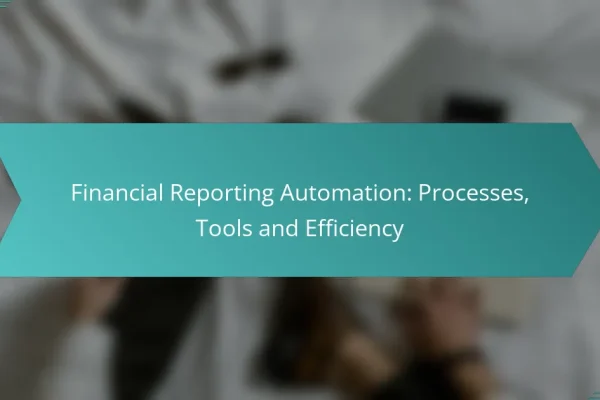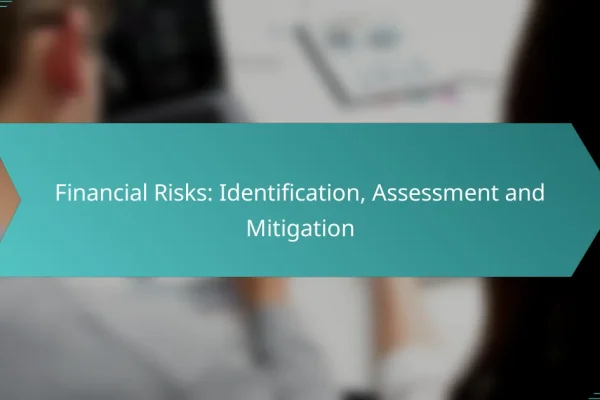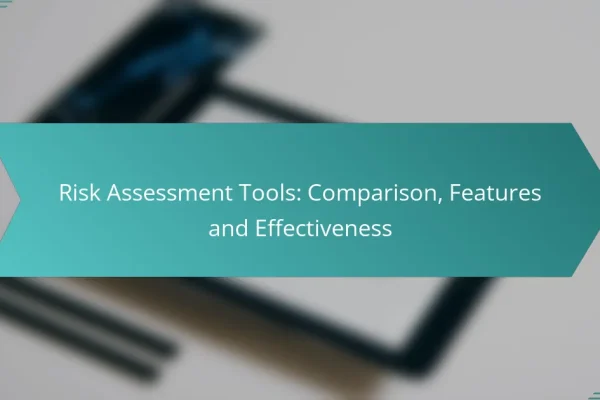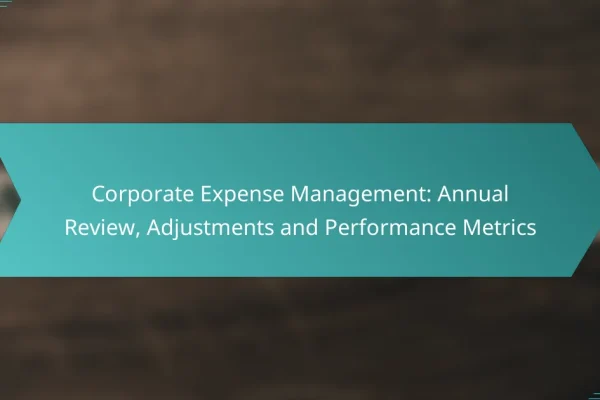
Mobile Expense Tracking: Accessibility, Efficiency and User Experience
Mobile expense tracking apps are designed to simplify the process of managing finances, enabling users…
Maximizing corporate expense management efficiency is crucial for organizations aiming to control costs and improve compliance. By leveraging technology and implementing tailored best practices, companies can streamline their processes, enhance reporting accuracy, and gain real-time insights into their spending. Adopting automated tools and establishing clear guidelines are key steps in achieving these goals.

Mobile expense tracking apps are designed to simplify the process of managing finances, enabling users to easily record and monitor their expenses from anywhere. With features that enhance accessibility and efficiency, these apps cater to a wide range of users, ensuring that financial management is both straightforward and effective. What are the best mobile expense…

Financial reporting standards play a crucial role in enhancing corporate transparency by providing structured guidelines for the preparation and presentation of financial statements. By ensuring that financial information is accurate, consistent, and accessible, these standards empower stakeholders to make well-informed decisions. The International Financial Reporting Standards (IFRS) and Generally Accepted Accounting Principles (GAAP) are the…

Financial reporting automation revolutionizes the way organizations generate and manage their financial reports by enhancing accuracy and efficiency. By streamlining key processes such as data collection, processing, and report generation, these tools minimize manual intervention and allow finance teams to focus on strategic analysis. Selecting the right automation tool tailored to your business needs is…

Effective corporate expense management is crucial for aligning financial goals and optimizing resource allocations within organizations. By fostering collaborative planning and utilizing advanced tools for communication and tracking, companies can enhance team dynamics and improve overall efficiency. Clear communication and defined roles further contribute to a culture of transparency, leading to better financial oversight and…

Insurance plays a crucial role in safeguarding individuals and businesses from financial loss by providing various types of coverage, such as health, auto, homeowners, life, and business insurance. By transferring the financial burden of potential risks to an insurer, policyholders can navigate unforeseen events with greater confidence and security. This essential protection not only offers…

Financial risks pose significant challenges to businesses, encompassing market, credit, operational, liquidity, and regulatory risks. Identifying these risks through thorough analysis of operations and market conditions is crucial for maintaining profitability and stability. By employing a blend of quantitative and qualitative assessment techniques, organizations can effectively evaluate potential threats and develop strategies for mitigation. What…

Risk assessment tools are essential for organizations seeking to identify, analyze, and mitigate potential risks effectively. With a wide range of features and varying levels of usability, these tools cater to diverse industry needs and regulatory requirements. Understanding the differences among them is crucial for selecting the most suitable option to enhance data integration, reporting,…

Compliance in financial reporting is crucial for organizations to maintain accuracy and transparency while adhering to regulatory requirements. Key strategies include adopting international standards, implementing robust internal controls, and engaging with external auditors. However, organizations face significant challenges, such as navigating complex regulations and adapting to rapid changes in standards, which necessitate effective resource allocation…

Effective corporate expense management is crucial for maintaining financial health and accountability within an organization. An annual review of expenses allows companies to identify trends and inefficiencies, enabling strategic adjustments to enhance efficiency and control costs. By refining policies and reallocating budgets based on these insights, organizations can optimize their financial performance and ensure resources…

Understanding the differences between GAAP (Generally Accepted Accounting Principles) and IFRS (International Financial Reporting Standards) is essential for companies operating in diverse markets. While U.S. firms typically follow GAAP, international businesses often adopt IFRS to maintain consistency across borders. The choice of framework can significantly impact financial reporting, making it crucial to consider regulatory requirements…
Companies in New York can enhance expense management efficiency by leveraging technology and implementing best practices tailored to their operational needs. Key strategies include automating reporting processes, utilizing real-time tracking tools, and adopting corporate credit cards with built-in expense controls.
Automated expense reporting tools streamline the process of submitting and approving expenses, reducing manual errors and saving time. These tools often integrate with accounting software, allowing for seamless data transfer and real-time visibility into spending patterns.
When selecting an automated tool, consider features such as mobile access, receipt scanning, and customizable approval workflows. Popular options include Expensify and Concur, which cater to various business sizes and needs.
Real-time expense tracking software enables companies to monitor spending as it occurs, providing immediate insights into budget adherence and cash flow. This proactive approach helps identify overspending trends and allows for timely adjustments.
Look for software that offers dashboards and reporting capabilities to visualize expenses effectively. Tools like Zoho Expense and QuickBooks can provide valuable analytics for informed decision-making.
Corporate credit cards equipped with expense controls help manage employee spending by setting limits and categorizing purchases. This not only simplifies expense tracking but also enhances accountability among employees.
Choose cards that offer features such as transaction alerts, spending limits, and integration with expense management systems. Cards from providers like American Express and Visa often come with these functionalities, making them suitable for businesses aiming to tighten expense oversight.
The best practices for expense management focus on establishing clear guidelines, providing regular training, and utilizing technology to streamline processes. These practices help organizations control costs, enhance compliance, and improve overall efficiency in managing expenses.
Clear expense policies are essential for effective expense management. They should outline what expenses are reimbursable, the approval process, and any limits on spending. For instance, policies might specify that travel expenses must be pre-approved and that meals are capped at a certain amount per day.
To create effective policies, involve key stakeholders in the drafting process and ensure they align with the company's financial goals. Regularly review and update these policies to reflect changes in regulations or business needs.
Regular training ensures that employees understand the expense policies and procedures, reducing the likelihood of errors and non-compliance. Training sessions can cover how to submit expenses, what documentation is required, and the importance of adhering to company policies.
Consider implementing a mix of training formats, such as in-person workshops, online courses, and quick reference guides. Frequent refreshers can help maintain awareness, especially when policies change or new employees join the organization.
Several tools can significantly improve corporate expense management by automating processes, ensuring compliance, and providing real-time insights. Selecting the right software can lead to better tracking, reporting, and ultimately, cost savings.
Expensify simplifies expense reporting by allowing employees to capture receipts and submit expenses via a mobile app. Users can categorize expenses, track mileage, and even integrate with accounting software for seamless data transfer.
Consider using Expensify if your organization values quick and easy reporting. Its SmartScan technology extracts data from receipts, reducing manual entry and saving time. This tool is particularly useful for teams that travel frequently and need to manage expenses on the go.
Concur offers a comprehensive solution that combines travel booking with expense management, making it easier for companies to control costs. Employees can book travel and manage expenses in one platform, ensuring that all spending is tracked and reported accurately.
This tool is ideal for larger organizations that require robust reporting features and integration with existing financial systems. Concur's ability to enforce travel policies and provide insights into spending patterns can lead to significant savings over time.
Zoho Expense focuses on budget tracking and expense reporting, allowing businesses to set budgets for different departments or projects. Users can monitor spending against these budgets in real-time, helping to prevent overspending.
Utilizing Zoho Expense can be beneficial for companies looking to maintain strict budget controls. Its user-friendly interface and customizable reports make it easy to analyze spending trends and adjust budgets as necessary. This tool is particularly effective for small to medium-sized enterprises that need to keep a close eye on their financial resources.
Tracking the right metrics for expense management is crucial for optimizing financial performance. Key metrics include the expense-to-revenue ratio and the average processing time for expense reports, both of which provide insights into cost efficiency and operational effectiveness.
The expense-to-revenue ratio measures the proportion of expenses relative to total revenue, indicating how efficiently a company is managing its costs. A lower ratio suggests better cost control, while a higher ratio may signal potential financial issues.
To calculate this ratio, divide total expenses by total revenue and multiply by 100 to get a percentage. For example, if a company has $200,000 in expenses and $1,000,000 in revenue, the ratio would be 20%. Aim for a ratio in the low tens of percent for healthy financial management.
The average processing time for expense reports reflects how quickly expenses are reviewed and reimbursed. Shorter processing times improve employee satisfaction and cash flow, while longer times can lead to frustration and inefficiencies.
To calculate this metric, track the time from when an expense report is submitted to when it is approved and reimbursed. Aiming for processing times in the range of single-digit days can enhance operational efficiency and employee morale. Implementing automated expense management systems can significantly reduce processing times.
Technology significantly enhances expense management by automating processes, improving accuracy, and providing real-time insights. This allows companies to streamline their financial operations, reduce errors, and make informed decisions based on data-driven analytics.
AI-driven predictive analytics can forecast spending patterns by analyzing historical data and identifying trends. This helps organizations anticipate future expenses, allowing for better budget planning and resource allocation.
For instance, businesses can utilize AI tools to analyze past travel expenses and predict future costs, helping to set more accurate budgets. Additionally, these insights can reveal potential areas for cost savings, such as identifying frequently over-budget categories.
Mobile applications enable employees to report expenses in real-time, enhancing convenience and accuracy. With features like photo receipt capture and instant submission, these apps reduce the time spent on manual entry and improve compliance with company policies.
For example, an employee traveling for business can quickly snap a picture of a receipt and submit it through the app, ensuring timely reimbursement. Companies should choose apps that integrate with existing accounting systems to streamline the expense approval process and maintain accurate financial records.
Common challenges in expense management include fraud detection, employee compliance with policies, and the complexity of tracking expenses accurately. Organizations often struggle to implement effective controls that prevent fraudulent activities while ensuring that employees adhere to established guidelines.
Fraud detection and prevention are critical components of effective expense management. Companies must establish robust systems to identify suspicious transactions and mitigate risks. This can involve using automated tools that flag anomalies, such as expenses that exceed typical limits or duplicate submissions.
Regular audits and employee training can further enhance fraud prevention efforts. For instance, educating staff on the types of fraud and the importance of reporting suspicious activities can create a culture of accountability. Implementing a clear reporting process is essential for encouraging employees to come forward without fear of repercussions.
Ensuring employee compliance with expense policies is vital for maintaining budget integrity. Clear communication of policies and expectations is necessary to minimize misunderstandings. Organizations should provide accessible resources, such as a detailed expense policy manual or an online portal, to guide employees in their spending.
Regularly reviewing and updating policies can help address any gaps and adapt to changing business needs. Additionally, utilizing expense management software can streamline the submission process, making it easier for employees to comply with guidelines. Consider implementing a checklist for employees to follow when submitting expenses to reduce errors and improve adherence.
Companies can ensure compliance in expense management by implementing clear policies, conducting regular audits, and utilizing technology to track expenses. Establishing guidelines helps employees understand acceptable spending, while audits and software solutions can identify discrepancies and ensure adherence to regulations.
Regular audits of expense reports are crucial for maintaining compliance and identifying potential fraud. By systematically reviewing submitted expenses, companies can ensure that all claims align with established policies and are supported by appropriate documentation.
To conduct effective audits, companies should establish a schedule, such as monthly or quarterly reviews, depending on the volume of expenses. Utilizing automated tools can streamline this process, allowing for quicker identification of anomalies and reducing the administrative burden on staff.
Common pitfalls include overlooking small discrepancies or failing to follow up on flagged items. It is essential to create a checklist for auditors that includes verifying receipts, checking for duplicate claims, and ensuring that expenses fall within budgetary limits.